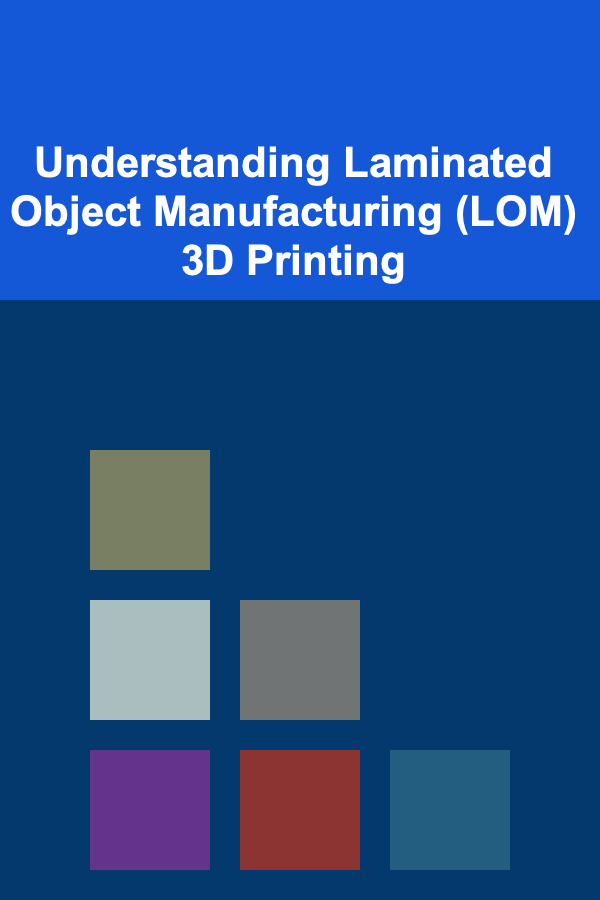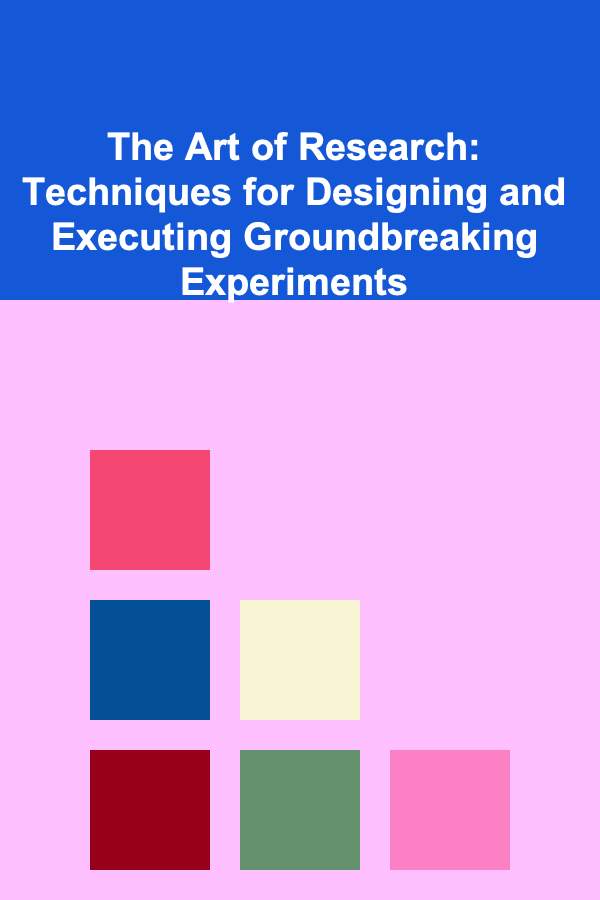
Understanding Laminated Object Manufacturing (LOM) 3D Printing
ebook include PDF & Audio bundle (Micro Guide)
$12.99$6.99
Limited Time Offer! Order within the next:

Introduction to Laminated Object Manufacturing (LOM)
Laminated Object Manufacturing (LOM) is an additive manufacturing (AM) process, more commonly known as 3D printing, that builds three-dimensional objects layer by layer from sheets of material. Unlike other 3D printing technologies that rely on melting or sintering materials, LOM uses a subtractive element combined with additive layer construction. It is a unique and somewhat less common method, but it holds specific advantages for certain applications, particularly those requiring large parts or specific material properties. This method offers a different approach to creating complex geometries compared to fused deposition modeling (FDM), stereolithography (SLA), or selective laser sintering (SLS).
This article will delve deep into the LOM process, exploring its history, mechanics, material options, advantages, disadvantages, applications, and future prospects. We aim to provide a comprehensive understanding of this intriguing 3D printing technology.
The History and Evolution of LOM
The LOM process was pioneered by Michael Feygin at Helisys Inc. in the late 1980s. Helisys commercialized the technology in the early 1990s, offering LOM machines as a rapid prototyping solution. The initial goal was to provide a method for creating large, functional parts quickly and affordably, bypassing the limitations of traditional machining and molding processes.
The early LOM systems primarily used paper as the build material, offering a relatively inexpensive way to create prototypes. However, the limitations of paper in terms of strength and durability led to the exploration of other materials, including plastics, composites, and even metals. While the core principles of LOM have remained consistent, advancements in cutting techniques, material bonding, and post-processing have expanded the capabilities and applications of this technology. While Helisys is no longer active, their initial work laid the foundation for subsequent LOM implementations and variations.
The LOM Process: A Step-by-Step Explanation
The LOM process consists of several key steps:
- CAD Model Preparation: The process begins with a 3D model designed using CAD (Computer-Aided Design) software. This model is then "sliced" into a series of cross-sectional layers, each representing a thin sheet of the build material. The slicing software determines the cutting paths for each layer.
- Material Feeding and Positioning: A sheet of the chosen build material, such as paper, plastic, or composite, is fed from a roll onto the build platform. Precise positioning is crucial to ensure accurate layer alignment.
- Layer Cutting (Contouring): A laser, knife, or other cutting tool (historically, a CO2 laser was commonly used) precisely cuts the outline of the cross-sectional layer onto the material. This cuts out the shape representing the part's geometry for that layer. The remaining material surrounding the part is often cross-hatched or otherwise segmented to facilitate easy removal later.
- Layer Bonding: After the layer is cut, it is bonded to the previous layer using a heated roller or adhesive. This bonding process ensures that the layers adhere to each other, creating a solid, three-dimensional structure. The heated roller melts a thin layer of adhesive already present on the sheet material, or activates a separate adhesive layer applied between sheets.
- Platform Lowering and Material Advance: The build platform is lowered by the thickness of one layer, and a new sheet of material is advanced into position for the next layer to be built.
- Repetition: Steps 2-5 are repeated until the entire object is built, layer by layer.
- Part Removal and Post-Processing: Once the build is complete, the object is removed from the surrounding waste material. This requires breaking away the segmented, cross-hatched portions of the build material. Post-processing steps may include sanding, coating, or other finishing techniques to improve the surface finish and mechanical properties of the part.
Simplified Diagram: Imagine stacking sheets of paper, each precisely cut into the shape of a specific layer of your object. You glue each sheet to the sheet below it. After stacking and gluing all the layers, you have a 3D object made from laminated paper. The LOM process automates this with precise cutting and bonding mechanisms.
Materials Used in LOM
The versatility of LOM lies, in part, in the variety of materials that can be used. The suitability of a material depends heavily on its ability to be laminated and cut precisely. Here are some of the common materials used in LOM:
- Paper: This was the original and remains a common material for LOM, especially for creating concept models and prototypes. Paper is inexpensive and readily available, making it a cost-effective option. However, it has limited strength and is susceptible to moisture.
- Plastics: A range of plastics, including PVC (Polyvinyl Chloride), polycarbonate, and polypropylene, can be used in LOM. Plastic laminates offer improved strength and durability compared to paper. The choice of plastic depends on the desired properties of the final part.
- Composites: LOM can be used with composite materials, such as fiber-reinforced plastics. These materials offer high strength-to-weight ratios and can be tailored to specific performance requirements. Examples include fiberglass-reinforced polymers and carbon fiber laminates.
- Metals: While less common, metal LOM exists. It typically involves bonding thin sheets of metal foil or using metal-coated polymers. This area has seen less widespread adoption compared to other LOM material options.
- Ceramics: Similar to metals, ceramic LOM is less frequently used but has potential for specialized applications. The brittle nature of ceramics poses challenges in the lamination and cutting processes.
The key material requirements for LOM are that the material should be available in sheet form, capable of being precisely cut, and able to be bonded to adjacent layers effectively.
Advantages of LOM
LOM offers several advantages over other 3D printing technologies:
- Large Build Volume: LOM machines can typically accommodate larger build volumes than many other 3D printing technologies, making them suitable for creating large parts. This stems from the ease of scaling the sheet-based material handling system.
- Cost-Effectiveness for Certain Materials: Paper LOM, in particular, is a very cost-effective method for creating prototypes and models. The use of relatively inexpensive materials can significantly reduce production costs.
- Relatively Fast Build Speeds: Compared to some other 3D printing processes, LOM can offer relatively fast build speeds, especially for parts with simple geometries. The laser cutting process can be faster than layer-by-layer deposition in FDM, for instance.
- Material Variety: LOM can utilize a variety of materials, including paper, plastics, composites, and even metals, offering flexibility in material selection.
- No Support Structures Needed: The surrounding waste material acts as its own support structure, eliminating the need for designing and removing support structures. This simplifies the design and post-processing stages.
Disadvantages of LOM
Despite its advantages, LOM also has several limitations:
- Waste Material: A significant amount of material is wasted in the LOM process. The surrounding material that is cut away is not typically reusable. This can increase material costs and environmental impact.
- Limited Complexity: LOM struggles with very intricate internal geometries or enclosed cavities. Removing the waste material from these areas can be difficult or impossible. The process is best suited for parts with relatively simple external shapes.
- Layered Appearance: The layered nature of LOM parts is often visible on the surface, resulting in a stepped or striated appearance. This can require extensive post-processing to achieve a smooth surface finish.
- Material Properties: The mechanical properties of LOM parts can be anisotropic, meaning they vary depending on the direction. This is due to the layered structure and the bonding between layers. The Z-axis (layer build direction) is often the weakest.
- Delamination: There's a risk of delamination, where layers separate due to weak bonding or stress. This is particularly relevant for parts subjected to significant loads or environmental changes.
- Post-Processing Requirements: LOM parts often require extensive post-processing to remove the surrounding waste material, smooth the surface, and improve the part's appearance and properties. This can add time and cost to the overall process.
Applications of LOM
LOM finds applications in various industries where its strengths outweigh its limitations. Here are some examples:
- Prototyping: LOM is well-suited for creating large prototypes and concept models, especially when using paper as the build material. The cost-effectiveness and speed of paper LOM make it ideal for early-stage design validation.
- Architectural Modeling: Architects use LOM to create detailed models of buildings and structures. The ability to produce large-scale models with relatively low cost is a significant advantage.
- Packaging Design: LOM can be used to create prototypes of packaging designs, allowing designers to evaluate the form and fit of packaging before mass production.
- Pattern Making: LOM can produce patterns for various manufacturing processes, such as investment casting.
- Educational Models: The technology is utilized in educational settings to create tangible models for demonstrating complex concepts in engineering, science, and medicine.
- Geospatial Modeling: Creating topographical maps and terrain models is a potential application, although other methods are often preferred now.
LOM vs. Other 3D Printing Technologies
Comparing LOM to other prevalent 3D printing technologies highlights its unique characteristics and niche applications:
- LOM vs. Fused Deposition Modeling (FDM): FDM extrudes melted plastic filament to build parts layer by layer. FDM is generally more versatile in terms of geometry and material options, while LOM excels in producing larger parts and, in the case of paper LOM, offering lower material costs. FDM requires support structures for overhanging features, which LOM avoids due to the surrounding material. FDM also tends to have better material utilization.
- LOM vs. Stereolithography (SLA): SLA uses a laser to cure liquid resin layer by layer. SLA produces parts with high accuracy and smooth surface finishes, but it is typically limited to smaller build volumes and a narrower range of materials. LOM is better suited for large parts, but the surface finish and accuracy are generally lower than SLA. SLA also typically requires extensive support structure design and removal.
- LOM vs. Selective Laser Sintering (SLS): SLS uses a laser to fuse powder particles together layer by layer. SLS can create parts with complex geometries and good mechanical properties, but it is more expensive than LOM and typically involves more complex post-processing. SLS also offers a wider range of materials, including metals and ceramics directly, whereas LOM requires laminated sheets of these materials. SLS doesn't inherently require supports because the unsintered powder acts as its own support, similar to LOM.
- LOM vs. Binder Jetting: Binder jetting uses a liquid binder to selectively join powder particles, creating a solid object layer by layer. LOM offers advantages in terms of material costs for paper based options, but binder jetting can use a broader range of materials including metals and sand, with potential for full color prints. Binder jetting parts are typically weak in the "green" state and require sintering or infiltration to achieve full strength, adding to the complexity of the process.
Future Trends and Developments in LOM
While LOM is a relatively mature technology, there are ongoing efforts to improve its capabilities and expand its applications:
- Improved Material Bonding: Research is focused on developing stronger and more reliable bonding methods to reduce the risk of delamination and improve the mechanical properties of LOM parts. This includes exploring new adhesives and surface treatments.
- Advanced Cutting Techniques: Advancements in laser cutting technology and other cutting methods are enabling more precise and efficient cutting of materials, leading to improved accuracy and surface finish.
- Automated Material Removal: Developing automated systems for removing the surrounding waste material would significantly reduce post-processing time and labor costs.
- Integration with Other Technologies: Combining LOM with other manufacturing processes, such as CNC machining, could create hybrid manufacturing solutions that leverage the strengths of both technologies.
- Sustainable Materials: There is a growing interest in using more sustainable materials in LOM, such as recycled paper and biodegradable plastics. This aligns with the increasing emphasis on environmental responsibility.
- Metal LOM Advancements: Continued research and development into metal LOM processes could expand the application of LOM into industries requiring strong and durable metal parts, potentially through innovative methods of bonding or sintering metal laminates.
Conclusion
Laminated Object Manufacturing (LOM) is a unique 3D printing technology that offers distinct advantages for specific applications, particularly those requiring large parts or cost-effective prototyping. While it faces limitations in terms of material waste, geometric complexity, and surface finish, ongoing research and development are addressing these challenges. By understanding the LOM process, its strengths, and its weaknesses, engineers, designers, and manufacturers can make informed decisions about whether it is the right technology for their specific needs. While not as widely adopted as FDM or SLA, LOM continues to find its niche in various industries, and its future will likely be shaped by advancements in material science, cutting techniques, and automation. The future of LOM lies in overcoming its limitations and embracing its strengths to provide a valuable solution for specific manufacturing challenges.

The Art of Research: Techniques for Designing and Executing Groundbreaking Experiments
Read More
The Web Content Manager's Guide: Mastering the Art of Digital Storytelling
Read More
What Are the Best Ideas for Organizing Holiday Gift Wrapping Supplies?
Read More
Why You Need to Set Aside Time for Regular Decluttering
Read More
10 Tips for Conducting Effective Ergonomic Assessments
Read More
10 Tips for an Ultralight Hiking Checklist: Reducing Weight and Improving Performance
Read MoreOther Products

The Art of Research: Techniques for Designing and Executing Groundbreaking Experiments
Read More
The Web Content Manager's Guide: Mastering the Art of Digital Storytelling
Read More
What Are the Best Ideas for Organizing Holiday Gift Wrapping Supplies?
Read More
Why You Need to Set Aside Time for Regular Decluttering
Read More
10 Tips for Conducting Effective Ergonomic Assessments
Read More